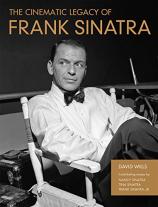The Cinematic Legacy of Frank Sinatra
Review
The Cinematic Legacy of Frank Sinatra
You get the feeling that most people think acting was just an afterthought for Frank Sinatra. He was a singer first --- perhaps the singer for a generation --- who made movies on the side. But even a cursory examination of THE CINEMATIC LEGACY OF FRANK SINATRA, David Wills’ wonderful tribute, shows a surprising depth of screen work.
Sure, Sinatra was cast as a singer early on, hardly a stretch. By the time he called it quits, however, he had dipped a toe into just about every genre: war, westerns, thrillers, noir, comedy --- in nearly 60 movies. Sinatra was always looking to learn and improve this skill set. He credited Gene Kelly --- with whom he appeared in three musicals --- for turning him into a credible, if not comparable, dancer.
"One reads THE CINEMATIC LEGACY OF FRANK SINATRA for the marvelous photos, which show Sinatra’s stunning transformation from a bow-tied skinny kid swimming in too-big jackets to a grizzled AARP-eligible fellow."
As he grew more comfortable and confident, Sinatra took on more challenging parts that were well-received by fans and critics. He won Best Actor in a Supporting Role for his turn as Angelo Maggio in From Here to Eternity in 1953 and was nominated for Best Actor two years later for the titular role in The Man with the Golden Arm. He also starred in such notable movies as the original version of The Manchurian Candidate, The Tender Trap, Pal Joey and Some Came Running, to name just a few, as well as his “Rat Pack” oeuvre, including Ocean’s 11 and Robin and the 7 Hoods, where he was able to work with chums like Dean Martin, Sammy Davis Jr., Joey Bishop and Peter Lawford.
Many of his cinematic contemporaries praised him for being generous with his time, belaying their fears of working with someone who had achieved legendary status in the music world. At the same time, Sinatra made little effort to hide impatience with more seasoned professionals, such as Marlon Brando, his co-star in Guys and Dolls and a practitioner of “the method” philosophy, whom Ol' Blue Eyes felt was perhaps a bit too deliberate in his craft.
The narrative --- provided mostly by Wills’ introduction --- is sparse, with little dishing about what went on behind the screen. He does note with a portion of respect and admiration the evolution of Sinatra as an actor. Additional insights come from essays by Sinatra’s children: Frank Jr., Nancy and Tina.
One reads THE CINEMATIC LEGACY OF FRANK SINATRA for the marvelous photos, which show Sinatra’s stunning transformation from a bow-tied skinny kid swimming in too-big jackets to a grizzled AARP-eligible fellow. Many of the pictures take up full pages in this impressive coffee table offering; the section devoted to The Man with the Golden Arm is particularly haunting.
The book could have benefited from a filmography appendix. It also might have done better had it been available in 2015, as we were celebrating Sinatra’s centennial.
Reviewed by Ron Kaplan on January 15, 2016
The Cinematic Legacy of Frank Sinatra
- Publication Date: January 5, 2016
- Genres: Entertainment, Nonfiction, Photography
- Hardcover: 304 pages
- Publisher: St. Martin's Press
- ISBN-10: 1250070805
- ISBN-13: 9781250070807




